Debit Surge Has Ripple Effects On Networks And Issuers

We may be catching a glimpse of economic life beyond the pandemic. The Congressional Budget Office said on Monday (Feb. 1) that it sees gross domestic product (GDP) returning to pre-pandemic levels by the middle of this year. But it’ll take some time, as The Wall Street Journal noted, before we get back to the employment rosters seen before COVID-19 hit last year.
That gives us a hint as to what might happen with debit spending, in a trend that was well-evidenced through the latest (and ongoing) earnings season. Namely, it will continue to be a favored payment method among consumers.
To get a sense of the update, at least as seen in data from reports tied to the December quarter, the card networks showed pent-up demand to spend – and though cross-border activity was down double digits, there were notable bright spots. Increases in debit spending helped to buoy results, overall. Consider the fact that, for example, Visa’s overall payments volume was up 4 percent year over year. For the network giant, debit volumes were up 20 percent to $1.2 trillion, while credit slipped 9 percent.
Mastercard, for its part, said that its own gross dollar volumes were up 1 percent in the quarter, with gross dollar debit spending up 8.5 percent year on year, while credit was down roughly 7 percent. Both firms’ management stated during their respective earnings calls that debit spending remained healthy subsequent to the end of the quarter.
The issuers, too, have seen surges in debit spending. Wells Fargo stated that debit card purchase spending was up 11 percent; J.P. Morgan said debit spending was up 12 percent, while credit spending slipped 4 percent.
As to where that debit spend is going: J.P. Morgan management said in its commentary that debit was being used for “everyday spend,” while credit sales have been negatively impacted by slumps in travel and entertainment-related activity. Mastercard CFO Sachin Mehra said that, post-quarter-close, “in terms of spend levels in the U.S. in the first three weeks as well as from a mixed standpoint, what we’re seeing is being more weighted to debit.”
Added Michael Miebach, Mastercard CEO, current trends echo the past: “What we’ve seen in previous challenged periods in terms of economic outlook … in a downturn, debit is … generally preferred.” Visa noted, too, that debit spending has been high in the wake of repeated waves of stimulus payments deposited directly onto debit cards or in bank accounts.
Interchange rates levied on debit transactions are generally lower than those seen on credit cards, depending on the issuing bank and a number of variables, but the simple math shakes out: More debit transactions (with lower fees paid by merchants, so merchants save money) and declining credit transactions (with higher fees paid by merchants) eventually may impact margins.
PYMNTS’ own research has shown that 59 percent of more than 2,270 consumers are finding it harder to pay their bills, and of those who were determined to be living paycheck to paycheck, only 30 percent of respondents said they prefer to pay for their eCommerce purchases with credit cards; about half opt for debit cards.
But buy now, pay later (BNPL) options are gaining some traction. The study found that 18 percent of financially insecure consumers used BNPL when purchasing online, and a little over 11 percent used it in-store. For the networks, there may be some silver lining here, where they have seen at least some business that otherwise might have not come, particularly in debit, and where FinTechs such as Afterpay and others are making inroads.
As reported in July, Visa Installments, a new point-of-sale (POS) credit solution, debuted in pilot markets across the U.S. This follows a pilot rollout in Russia earlier in the year.
“Given how much the demand for installments is increasing, we are also using the already existing parts of the credit system today to scale installment payments with every [Visa] card across the board,” Cetin Duransoy, Visa’s global head of installment solutions, told PYMNTS.
Separately, Mastercard said in September that it partnered with TSYS on BNPL efforts. In terms of mechanics, generally speaking, transactions can be split into installments at the point of checkout, which helps merchants boost ticket sizes and conversion rates.
For the networks, BNPL can be seen as further evidence that cards are focusing on the rails (rather than, say, simply getting as many cards into hands as possible), meeting consumers in the ways in which they want to pay.
Visa CEO Alfred Kelly said on the most recent earnings call that installments represent “a pretty interesting space, and I think we’re in the early days in most markets. There’s a number of different models … We’re not in the business of picking winners and losers. We see our job as enablement no matter what the model is.” He noted that there exist, for consumers, “multiple ways to pay off installments: virtual cards, debit cards and ACH.”
